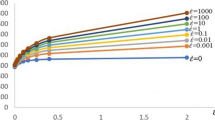Abstract
Drag finishing is a highly attractive finishing technology for ductile metals as it combines the features of loose abrasive technologies with the high automation level and control of metal cutting (machining) technologies. Fluidized bed assisted drag finishing provides the additional advantage to simplify the moving device of the workpiece. In addition, fluidization reduces the energy consumption necessary to move the workpiece through the abrasives, which, being taken in a fluid-like state, offer less resistance to the advancing workpiece. This technology was proved to ensure high-quality finishing of ductile metals like brass, whose surface can be easily processed to become mirror-like. Although experimental practice has allowed to raise significant knowledge in the field, the comprehension of the basic mechanisms involved during finishing process and theoretical modeling of the related material removal are still missing. The present work attempts to model the material removal during fluidized bed of ductile metals by combining the theory of localization of plastic deformation during abrasive–workpiece impacts with an energy absorption approach.
Similar content being viewed by others
References
Rowe WB (2014) Principles of modern grinding technology, 2nd edition. William Andrew (imprint of Elsevier), Kidlington
Marinescu ID, Rowe WB, Dimitrov B, Ohmori H (2013) Chapter 13—loose abrasive processes. In: Rowe WB, Dimitrov B, Ohmori H (eds) Tirbology of abrasive machining processes, 2nd edition. William Andrew (imprint of Elsevier), Kidlington, pp 399–421
Jain VK, Adsul SG (2000) Experimental investigations into abrasive flow machining (AFM). Int J Mach Tools Manuf 40:1003–1021
Barletta M (2009) Progress in abrasive fluidized bed machining. J Mater Process Technol 209:6087–6102
Davidson DA (2008) Vibratory finishing: versatile, effective, and reliable. Met Finish 106:30–34
Finnie I (1960) Erosion of surfaces by solid particles. Wear 3:87–103
Finnie I, Mc Fadden DH (1978) On the velocity dependence of the erosion of ductile metals by solid particles at low angle of incidence. Wear 48:181–190
Sundararajan G, Shewmon PG (1983) A new model for the erosion of metals at normal incidence. Wear 84:237–258
Sundararajan G (1991) A comprehensive model for the solid particle erosion of ductile materials. Wear 149:111–127
Brach RM (1988) Impact dynamics with applications to solid particle erosion. Int J Impact Eng 7(1):37–53
Jain NK, Jain VK (2001) Modeling of material removal in mechanical type advanced machining processes: a state-of-art review. Int J Mach Tools Manuf 41:1573–1635
Kunii D, Levenspiell O (1991) Fluidization engineering. Butterworth-Heinemann, Reed, Newton
Čatipović NM, Jovanovic GN, Fitzgerald TJ (1978) Regimes of fluidization for large particles. AIChE J 24:543–547
Rios GM, Baxerres JL, Gibert H (1980) Potential improvements in the field of large particle fluidization. In: Grace JR et al (eds) Fluidization. Plenum Press, New York City
Kenton T (2009) The future of mechanical surface finishing. Met Finish 107:22–24
Barletta M, Gisario A, Venettacci S, Rubino G (2014) A comparative evaluation of fluidized bed assisted drag finishing and centrifugal disk dry finishing. Eng Sci Technol Int J 17:63–72
Johnson KL (1985) Contact mechanics. Cambridge University Press, Cambridge
Venugopal Reddy A, Sundararajan G, Sivakumar R, Rama Rao P (1984) Acta Metall 32:1305
Willis R (1870) Principles of mechanism, second edition, 2nd edn. Longmans, Green and Co., London
Barletta M, Guarino S (2010) High speed finishing of a CuZn15 brass alloy by abrasive recirculating fluidized bed (ARFB). Powder Technol 203:591–602
Barletta M (2006) A new technology in surface finishing: fluidized bed machining (FBM) of aluminium alloys. J Mater Process Technol 173:157–165
Kopac J, Krajnik P (2006) High-performance grinding—a review. J Mater Process Technol 175:278–284
Buj-Corral I, Vivancos-Calvet J, Coba-Salcedo M (2014) Modelling of surface finish and material removal rate in rough honing. Precis Eng 38:100–108
Evans CJ, Paul E, Dornfeld D, Lucca DA, Byrne G, Tricard M, Klocke F, Dambon O, Mullany BA (2003) Material removal mechanisms in lapping and polishing. CIRP Ann Manuf Technol 52:611–633
Author information
Authors and Affiliations
Corresponding author
Rights and permissions
About this article
Cite this article
Barletta, M., Rubino, G. & Valentini, P.P. Experimental investigation and modeling of fluidized bed assisted drag finishing according to the theory of localization of plastic deformation and energy absorption. Int J Adv Manuf Technol 77, 2165–2180 (2015). https://doi.org/10.1007/s00170-014-6620-y
Received:
Accepted:
Published:
Issue Date:
DOI: https://doi.org/10.1007/s00170-014-6620-y




